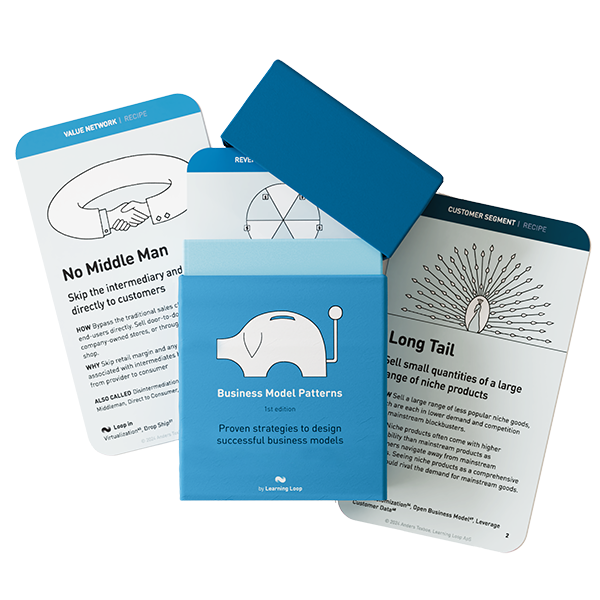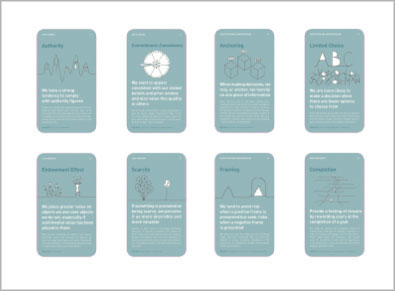Business Model Generation: Value proposition
White Label
Allow partners to sell your product under their brand

How: Construct your product in such a way that its brand identity can be customized with only a few stylistic changes and let multiple partners sell it under different brands.
Why: Enable customers to focus on their core business rather than maintaining infrastructure while gaining new marketing channels and revenue streams.
What is White Labeling?
White Label goods, also known as “no-name” goods, are manufactured without a specific name, and subsequently sold by various companies under different names and in different market segments. This business model offers several advantages, the foremost being that producers bear only the costs associated with product manufacturing. Additionally, the White Label company is able to focus on optimizing production processes, thereby increasing the chances of achieving economies of scale.
This model reduces costs for the reseller and allows them to rapidly expand their product range to take advantage of market trends. It also facilitates a long-term relationship between both parties.
The Flexibility of White Label Goods
Due to the lack of branding, vendors are able to market White Label goods in any manner they deem fit. This is particularly common in the food industry, where products may be manufactured at one facility, packaged differently, and sold by retailers under different names. The revenues generated from the sale of these unbranded goods can supplement those from branded products, thereby providing access to lower-income customers and alternative distribution channels.
Advantages of the White Label business model
- Lowering barriers to entry. White labeling allows sellers to enter new markets without having to delve into the complexities of product manufacturing, allowing them to focus on branding and marketing.
- Diversifying the market. White labeling introduces new products to the market and also allows for variations on existing products. This can include adding custom packaging to a mass-manufactured product, giving it a unique visual appeal.
- Economic efficiency. White label manufacturers can take advantage of economies of scale by producing goods in bulk, resulting in lower per-unit costs, which can be passed on to retailers.
- Cost Reduction. For companies with no manufacturing experience or those who want to avoid the expenses associated with product development, the business model offers huge cost savings. The white label business model saves time, money, and effort for the reseller.
- Responsive Expansion. The white label business model allows for a company to rapidly expand its product offering to take advantage of market trends and boost brand visibility. Since the product is already manufactured, more resources can be directed towards marketing and distribution. This is an efficient way for companies to grow and stay competitive in their industry.
- Long-term Relationships. The white label business model promotes a sustainable relationship between the manufacturer and the reseller. Both parties share mutual business interests and both have well-defined roles and responsibilities. Provided consumers remain unaware of the agreement, this model allows for a long-term, profitable partnership.
- Low risk and easy experimentation. As companies do not need to invest in expensive manufacturing, releasing a new White Label product is more risk free and lends itself to an experimental mindset, where releasing a new product as a short-term and low-cost experiment is possible.
Challenges of the White Label business model
- Limited customization. The constraints set by white label suppliers can limit the opportunities for fully customizing products.
- Price competition. White labeling can lead to price competition with other manufacturers that sell the same product under a different name.
- Order fulfillment. The reliance on a supplier for order fulfillment can be problematic if something goes wrong at their factory or shipping times lag, leaving manufacturers with few options and possibly forcing a switch to a different supplier.
How does white labeling differ from private labeling?
Private label products are similar to white-label products in that they are produced by one company and then rebranded by another company. The main difference between private label and white label products is that private label products are not necessarily mass-produced; they may be produced in smaller quantities specifically for a particular company. This may lead to higher costs for the marketer.
White Labelling
White Labelling refers to the removal of a brand from a product or service and its replacement with the brand of the purchasing company. For example, Walmart’s Great Value white label brand is produced by manufacturers who are willing to display the company’s brand rather than their own. The retailer of a white label product only has control over the appearance of the label, while the manufacturer retains control over the production, packaging, and ingredients of the product. As a result, the same product may be sold to multiple retailers under different brand names.
Private Labelling
Private Labelling, on the other hand, involves the selling of another company’s products using one’s own branding and packaging. A retailer may purchase products from a manufacturer and sell them to consumers with the manufacturer’s brand and packaging visible. Alternatively, a retailer may contract a third-party manufacturer to produce goods and sell them under the retailer’s brand, thus hiding the manufacturer’s brand from consumers. In Private Labelling, the retailer has control over every aspect of the process except the manufacture of the product itself, including the ingredients, packaging, distribution, and production volume. Private label products may also be on-sold to wholesalers.
A Business to Business approach
The white label business model is a business-to-business (B2B) approach involving a manufacturer and a reseller. There are three core components of the model:
- A manufacturer creates a white label product that has no name, label, logo, or branding.
- The manufacturer then sells the unbranded product to a reseller who is free to customize the product to suit their brand. In some cases, the same white label product may be sold to multiple resellers.
- The reseller then sells the now branded product to its customers. For the White Label business model to be effective, it is important customers are unaware of this process.
Where did the White Label business model pattern originate from?
The white label business model originates from the record industry, where a record producer would produce a track and then sell the rights to use that track to other record labels who would then release it under their own label.
White labeling is a practice that has been around for quite a while and has been used in many industries, such as manufacturing, retail, and technology. The concept of white labeling has its origins in the manufacturing of goods, where manufacturers would produce a bulk product that would then be sold to retailers or distributors who would then brand it with their own label and sell it as their own product.
The business model has become popular in technology industry where software development companies will create a product and then sell it to other companies who will then resell it under their own brand name. The practice is also common in retail, where manufacturers of products such as electronics, household items, and clothing will produce items and then sell them to retailers who will then sell them under their own brand name.
Applying the White Label business model
It is important for the White Label business model to maintain the illusion of distinct offerings, as customers may be deterred from purchasing the more expensive branded products if they realize that the cheaper substitution product is essentially the same. Moreover, production will be more efficient if it is possible to reach customers with differing product quality expectations, as very little extra work will often be needed in order to supply these additional customers.
Opting for a White Label strategy can be advantageous for businesses whose customers are highly price-sensitive and possess a firmly established brand. This business model has been effectively implemented in a variety of industries, particularly in the food and garment sectors. In order to begin utilizing the White Label model, it is recommended to initially introduce a limited number of products.
Permission for White Label products
To legally sell white label products under your own brand name, one must craft a manufacturing, branding, and sales agreement with a white label manufacturer. Such agreements should be crafted with the aid of a specialized attorney.
It is unethical, and frequently illegal, to take an existing product, relabel it, and resell it without the permission of the original manufacturer. Such a practice violates the spirit of white labeling and may expose one to a lawsuit if found to have violated a manufacturer’s terms of use.
Profitability of White Labeling
White labeling can be profitable for both the manufacturer and the seller. The manufacturer benefits from doing large-scale product runs, which lowers their per-unit cost of making a particular item. The seller can also profit because they can enter a market without needing to buy equipment, source raw materials, or hire specially trained manufacturing staff. They can operate with a lower overhead cost and jump into new markets more easily.
Typical cost structures of White Labeling
The costs associated with white labeling can vary depending on the product or service being rebranded, the quality of the product or service, and the quantity being purchased. Some common costs associated with white labeling include:
- Product or service costs. The cost of the original product or service that is being rebranded. This cost can vary depending on the product or service and the supplier.
- Branding and packaging costs. The cost of adding the rebranding company’s logo and branding to the product or service. This can include costs for design, printing, and packaging.
- Minimum order quantities (MOQs). Some suppliers may require a minimum order quantity to be purchased in order to white label their product.
- Shipping and handling. The cost of shipping the white labeled product from the supplier to the rebranding company’s location.
- Set up fee. Some supplier may charge a one-time set up fee for creating the new branding and packaging for the product.
The costs associated with white labeling are typically structured as a one-time cost for creating new branding and packaging, and then an ongoing cost for each unit of the product or service that is rebranded and sold. Some suppliers may offer discounts for larger order quantities. It’s also important to note that costs may vary depending on the supplier and the agreement that the company has with them. It’s essential to have a clear understanding of the costs and the terms of the agreement before entering into a white labeling partnership.
Legal or regulatory considerations
There are a number of legal and regulatory considerations when white labeling a product or service.
- Trademark infringement. It’s important to ensure that the product or service being rebranded does not infringe on any existing trademarks or copyrights. This can include issues with product names, logos, and packaging.
- Product liability. The company rebranding the product or service may be held liable for any issues or defects with the product, even if they did not produce it themselves.
- Compliance with industry regulations. Certain products and services are subject to specific regulations and standards. It’s important to ensure that the product or service being rebranded complies with these regulations and standards.
- Labeling and packaging requirements. Different countries may have different labeling and packaging requirements for certain products. It’s important to ensure that the product or service being rebranded complies with these requirements.
- FDA and other regulatory agencies. For products such as food and medicines, the company rebranding the product must comply with FDA and other regulatory agencies’ labeling and packaging requirements.
- Import and export laws. The company rebranding the product or service must comply with all import and export laws and regulations.
- Warranty and returns. The company rebranding the product or service must comply with any warranty and return policies set by the supplier, or develop their own, that is compliant with the laws of the country where it is being sold
It’s important to consult with a legal professional to ensure that the company is in compliance with all legal and regulatory requirements when white labeling a product or service.
Real life White Label examples
Dollar Shave Club
The razor and blade subscription service ship private-label products with their branding and fulfilment service on top.
Richelieu Foods
Its pizzas, dressings, and marinades are branded and sold by other companies including Aldi, Save-A-Lot, Sam’s Club, and others.
Dell
Dell is known for manufacturing computers for other companies to rebrand and sell as their own. Dell manufactures computers for companies like Alienware and GMC. Alienware is known for gaming computers, and GMC for rugged computers. Dell’s manufacturing capabilities allow these companies to focus on design and branding, while Dell takes care of the manufacturing process.
Starbucks
Starbucks is one of the most recognized coffee brands in the world, and it also sells its coffee beans to other companies for rebranding. Companies like grocery stores, cafes and hotels can purchase Starbucks coffee beans and rebrand them as their own. This allows these companies to offer high-quality coffee to their customers without having to invest in their own roasting facilities.
WP Engine
WP Engine is a leading website hosting company that also offers a white label solution for other companies. This allows other companies to resell WP Engine’s hosting services under their own brand, giving their customers access to the same high-quality hosting services without having to invest in their own infrastructure.
Shopify
Shopify is a leading e-commerce platform that also offers a white label solution for other companies. This allows other companies to resell Shopify’s e-commerce platform under their own brand, giving their customers access to the same high-quality e-commerce services without having to invest in their own development team.
Trigger Questions
- Can you gain economies of scale by reusing the same base product for multiple brands?
- Can you design your product in a way that adding branding is simply a matter of configuration: changing colours, logos, and typefaces?
- How do you go about finding a white labeling partner or supplier?
- How can you ensure the quality of white labeled products or services?
- How might we navigate any potential conflicts that may arise from selling premium brand products as White Label products?
- In the eyes of our customers, how is the value of our products perceived?
- What insights can we gain and how might we leverage our current premium brands in order to craft successful White Label products?
Proven business models that have driven success for global leaders across industries. Rethink how your business can create, deliver, and capture value.
Get your deck!Related plays
- Business Model Navigator by Karolin Frankenberger and Oliver Gassmann
- How White Label Marketing Creates Better Business Models: Fresh Insights by DigitalDoughnut.com
- White-Label vs Private Label: What are They? [Updated] by Vendasta
- What are the most successful White Label products? by Quora
- White-label product
- 8 Benefits to White Labeling by Jessie Jenkins
- What Is White Labeling? White Labeling Business Model In A Nutshell by Gennaro Cuofano

